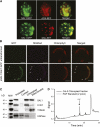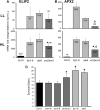Evidence for a SAL1-PAP chloroplast retrograde pathway that functions in drought and high light signaling in Arabidopsis
- PMID: 22128124
- PMCID: PMC3246320
- DOI: 10.1105/tpc.111.091033
Evidence for a SAL1-PAP chloroplast retrograde pathway that functions in drought and high light signaling in Arabidopsis
Abstract
Compartmentation of the eukaryotic cell requires a complex set of subcellular messages, including multiple retrograde signals from the chloroplast and mitochondria to the nucleus, to regulate gene expression. Here, we propose that one such signal is a phosphonucleotide (3'-phosphoadenosine 5'-phosphate [PAP]), which accumulates in Arabidopsis thaliana in response to drought and high light (HL) stress and that the enzyme SAL1 regulates its levels by dephosphorylating PAP to AMP. SAL1 accumulates in chloroplasts and mitochondria but not in the cytosol. sal1 mutants accumulate 20-fold more PAP without a marked change in inositol phosphate levels, demonstrating that PAP is a primary in vivo substrate. Significantly, transgenic targeting of SAL1 to either the nucleus or chloroplast of sal1 mutants lowers the total PAP levels and expression of the HL-inducible ASCORBATE PEROXIDASE2 gene. This indicates that PAP must be able to move between cellular compartments. The mode of action for PAP could be inhibition of 5' to 3' exoribonucleases (XRNs), as SAL1 and the nuclear XRNs modulate the expression of a similar subset of HL and drought-inducible genes, sal1 mutants accumulate XRN substrates, and PAP can inhibit yeast (Saccharomyces cerevisiae) XRNs. We propose a SAL1-PAP retrograde pathway that can alter nuclear gene expression during HL and drought stress.
Figures









Comment in
-
Retrograde signaling: a new candidate signaling molecule.Plant Cell. 2011 Nov;23(11):3870. doi: 10.1105/tpc.111.231113. Epub 2011 Nov 29. Plant Cell. 2011. PMID: 22128121 Free PMC article. No abstract available.
Similar articles
-
RNA Polymerase II Read-Through Promotes Expression of Neighboring Genes in SAL1-PAP-XRN Retrograde Signaling.Plant Physiol. 2018 Dec;178(4):1614-1630. doi: 10.1104/pp.18.00758. Epub 2018 Oct 9. Plant Physiol. 2018. PMID: 30301775 Free PMC article.
-
The PAP/SAL1 retrograde signaling pathway is involved in iron homeostasis.Plant Mol Biol. 2020 Feb;102(3):323-337. doi: 10.1007/s11103-019-00950-7. Epub 2020 Jan 3. Plant Mol Biol. 2020. PMID: 31900819
-
3'-Phosphoadenosine 5'-Phosphate Accumulation Delays the Circadian System.Plant Physiol. 2018 Apr;176(4):3120-3135. doi: 10.1104/pp.17.01611. Epub 2018 Feb 27. Plant Physiol. 2018. PMID: 29487119 Free PMC article.
-
Activity and roles of Arabidopsis thaliana XRN family exoribonucleases in noncoding RNA pathways.J Plant Res. 2017 Jan;130(1):25-31. doi: 10.1007/s10265-016-0887-z. Epub 2016 Dec 17. J Plant Res. 2017. PMID: 27988817 Review.
-
Secondary sulfur metabolism in cellular signalling and oxidative stress responses.J Exp Bot. 2019 Aug 19;70(16):4237-4250. doi: 10.1093/jxb/erz119. J Exp Bot. 2019. PMID: 30868163 Review.
Cited by
-
XRN 5'→3' exoribonucleases: structure, mechanisms and functions.Biochim Biophys Acta. 2013 Jun-Jul;1829(6-7):590-603. doi: 10.1016/j.bbagrm.2013.03.005. Epub 2013 Mar 19. Biochim Biophys Acta. 2013. PMID: 23517755 Free PMC article. Review.
-
The roles of two transcription factors, ABI4 and CBFA, in ABA and plastid signalling and stress responses.Plant Mol Biol. 2013 Nov;83(4-5):445-58. doi: 10.1007/s11103-013-0102-8. Epub 2013 Jul 6. Plant Mol Biol. 2013. PMID: 23832569
-
Methodology: an optimized, high-yield tomato leaf chloroplast isolation and stroma extraction protocol for proteomics analyses and identification of chloroplast co-localizing proteins.Plant Methods. 2020 Sep 24;16:131. doi: 10.1186/s13007-020-00667-5. eCollection 2020. Plant Methods. 2020. PMID: 32983250 Free PMC article.
-
Cyclin-dependent kinase E1 (CDKE1) provides a cellular switch in plants between growth and stress responses.J Biol Chem. 2013 Feb 1;288(5):3449-59. doi: 10.1074/jbc.M112.416727. Epub 2012 Dec 10. J Biol Chem. 2013. PMID: 23229550 Free PMC article.
-
Retrograde Signaling: Understanding the Communication between Organelles.Int J Mol Sci. 2020 Aug 26;21(17):6173. doi: 10.3390/ijms21176173. Int J Mol Sci. 2020. PMID: 32859110 Free PMC article. Review.
References
-
- Allison D.B., Cui X., Page G.P., Sabripour M. (2006). Microarray data analysis: From disarray to consolidation and consensus. Nat. Rev. Genet. 7: 55–65 - PubMed
-
- Aronsson H., Jarvis P. (2002). A simple method for isolating import-competent Arabidopsis chloroplasts. FEBS Lett. 529: 215–220 - PubMed
-
- Baldi P., Long A.D. (2001). A Bayesian framework for the analysis of microarray expression data: Regularized t -test and statistical inferences of gene changes. Bioinformatics 17: 509–519 - PubMed
-
- Ball L., Accotto G.-P., Bechtold U., Creissen G., Funck D., Jimenez A., Kular B., Leyland N., Mejia-Carranza J., Reynolds H., Karpinski S., Mullineaux P.M. (2004). Evidence for a direct link between glutathione biosynthesis and stress defense gene expression in Arabidopsis. Plant Cell 16: 2448–2462 - PMC - PubMed
Publication types
MeSH terms
Substances
LinkOut - more resources
Full Text Sources
Other Literature Sources
Molecular Biology Databases
Research Materials

